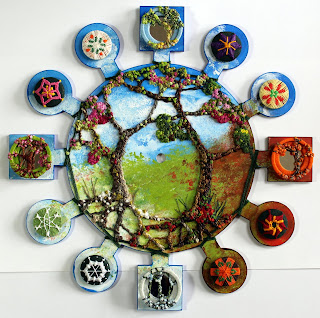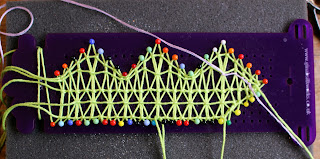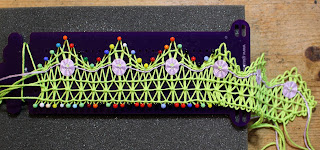I created 8 more thread wrapped and embroidered buttons to fit the Spring, Summer, Autumn and Winter theme for display around the perimeter. Instructions were from various button kits available from Gina along with my own thread stash and colours. Kits included the Victorian Button Journal Kit, Snowflake Button Pattern Pack and the Woven Button Motifs Design Booklet.
I created 8 more thread wrapped and embroidered buttons to fit the Spring, Summer, Autumn and Winter theme for display around the perimeter. Instructions were from various button kits available from Gina along with my own thread stash and colours. Kits included the Victorian Button Journal Kit, Snowflake Button Pattern Pack and the Woven Button Motifs Design Booklet.
Materials
- MDF Button Display Clock Set (Gina B Silkworks)
- 4 Seasons Mirror Button Brooch Kit (Gina B Silkworks)
- Victorian Button Journal Kit (Gina B Silkworks)
- Woven Button Motifs Design Booklet (Gina B Silkworks)
- Snowflake Button Pattern Design Pack (Gina B Silkworks)
- Dark green fabric scrap (for covered buttons)
- Optional - 4 wooden button moulds with slight domed top (25mm from my stash)
- Embroidery Threads (mixed colours perle No.8, No.5 and stranded cottons - DMC and Anchor)
- White Gesso
- Acrylic paints (blue, green, red, orange, yellow and opaque titanium white)
- Synthetic paint brushes (for acrylics)
- Sea sponge
- Alcohol ink pens (dark blue and brown)
- Transparent Powertex
- Cotton rag (e.g. old cotton tea towel)
- Tempus Fugit clear cling stamp (unknown brand)
- Stazon Black Inkpad (Ranger - multi surface inkpad)
- Super Thick Slap It On (thick acrylic gel medium from Indigoblu)
Circle Button Gauges (helps with even placement of thread wraps and embroidery on buttons)
Button Makers Third hand Tool & Tin (contains beeswax and a third hand for holding part wrapped buttons when changing colours and finishing etc.)
How it was done:
Preparation of the buttons for display:
I first created the 4 Seasons Mirror Buttons as given in Gina’s kit instructions. The kit contains enough materials to create 8 buttons; 2 of each of the 4 seasons. It also contains all the components, threads and needles required.
With one set of buttons I created 4 pendants (they are intended for making a necklace or brooch).
My second set of buttons were used for my clock display to place on each of the 4 main quadrants.
I next worked 8 more buttons for the display, 2 more for each seasonal clock quadrant. Instructions were followed from Gina’s Original Snowflake Pattern Designs, Victorian Button Journal Kit or from her Woven Button Motif Design Booklet. You could include any buttons that you like by creating in colours and designs to suit the seasons.
Four buttons were made on fabric covered slightly domed wooden moulds from my stash. You can use the 25mm flat button moulds included in the clock kit instead. Just cut some felt circles to place on the button front before covering to give a bit of padding and shape.
To cover my buttons I cut fabric circles approx. 45mm in diameter (i.e. enough to cover front and wrap around back of button). I then worked a row of running stitch to gather up and pull in the fabric over the button back.
I then worked designs from Gina’s Original Snowflake Buttons Designs or from her Victorian Button Journal Kit.
Top Left – Spring Button: Victorian Bordered Star pattern in pink perle cotton. I embellished with extra stitching and French knots in yellow perle cotton.
Top Right – Winter Button: Snowflake pattern C in white perle cotton, working on a fabric base rather than a thread wrapped button base. I also added a little extra stitching around the perimeter.
Bottom Left – Summer Button: Victorian Flower pattern in purple and yellow perle cotton. I added some extra French knots to the centre.
Bottom Right – Autumn Button: Victorian Lace Circle pattern in red and yellow perle cotton.
The next 4 buttons were worked on 25mm flat button moulds as included with the clock kit. I worked designs from Gina’s Original Snowflake Buttons Designs or from her Woven Button Motif Design Booklet.
Top Left – Spring Button: Woven Button Flower Sprig design in off white, green and orange perle cotton.
Top Right – Autumn Button: Woven Button Leaf Style 3 design in brown & orange perle cotton for the base wrap and green for leaves.
Bottom Left – Summer Button: Woven Button Lavender Flower design in pale yellow perle cotton for base and green & orange for woven flower.
Bottom Right – Winter Button: I worked a 6 point wrap with perle No.8 pale green thread and worked the Snowflake Pattern B with white perle No.8 thread.
Decorating the clock:
I first covered my clock base with white Gesso. This step is not essential but it provides a good base for painting. A clean bright base will show acrylic colours to their best. Particularly if using semi transparent acrylic colours (different paints vary in opacity) where the MDF base colour would affect the overall colour of subsequent painted layers). It also saves acrylic paint as it stops paint absorbing into the porous MDF.
The clock was then painted with acrylics to create a background scene on which to work the embroidery.
In keeping with the 4 seasons theme I painted a background sky with clouds on the top half of the clock (which will be my Spring and Summer clock quadrants). In the lower right foreground I introduced greens, browns and red to represent the Autumn colours. In the lower left I used pale and white colours for my Winter quadrant.
I introduced texture by ‘stamping’ paint onto the surface using the sea sponge. This was worked really quickly and randomly, just to give the impression of foliage. It is important to rinse paint out of the sponge quickly when done (acrylics dry very quickly and will ruin the sponge if left to dry).
Once the paints were dry I used alcohol markers around the clock edges to neaten and to frame.
I laid out the buttons into their positions to check how they looked (not stuck down yet).
Dark green perle 8 cotton was used to wrap around the thread spokes. This was to create an outer frame on which to anchor the tree embroidery.
I wrapped around the edge of the clock 3 times to create a neat frame. I used a little Transparent Powertex on the back of the clock (behind the spokes) to anchor and glue the threads down securely and prevent them working loose (leaving the front threads free).
Next the main tree trunks, branches and roots were created using similar techniques as used in Gina’s 4 Seasons Mirror Buttons – only on a much larger scale. I didn’t take a lot of step by step pictures here (sorry) but will try and talk through how I went about it with tips to help you create similar.
While working this embroidery it is really important not to add too much thickness or depth which would impede movement or catch on the clock hands. I tried on the hands to work out the clearance needed, paying particular attention to the short hand which fits closest to the clock base (subsequent hands fit slightly further outward). The clock hands are fairly soft metal so can be very gently eased upward slightly if needed (if you do this you would need to adjust the angle of all the hands so that they don’t catch on each other). The tightest depth area is in the very centre of the clock so I kept this area free of embroidery.
Should you have a bit of a disaster don’t fret. After all that hard work, all is not lost. Clock fittings are easily available from various online sources with different spindle depths, so a fitting with a longer spindle could be substituted if needed.
To work the trunks, branches and roots I used a mix of perle 5 and 8 threads in browns, greys, and creams. Stranded cotton threads could also be used, splitting them down and working with 3 or 4 individual strands together.
To start I tied thread onto the outer frame and worked back and forth laying threads loosely across the clock, tying top and bottom to make the main trunk foundation. Next I started weaving and wrapping threads, working up and down the trunk and taking branches and roots off to the edge. As the extra branches were worked the embroidery was pulled more tightly to hold it flatter. This tightened up the main trunks. Weaving and wrapping also tightened things up.
I first worked the right hand tree using warmer, deeper and richer browns and creams. This half represents the Summer and Autumn quadrants. I then worked the left hand tree in cooler colours to represent Spring and Winter sections. Where the branches intersected I was careful not to increase the embroidery depth, working branches that intersect in sections (rather than creating a double thickness where branches crossed).
Here is a closer view showing the colour contrasts and stitching detail. I tried to create the effect of light coming through the centre by using lighter colours on the inner tree trunks. I also added extra texture using occasional French knots.
I again laid out the buttons to see how they looked (not stuck down yet). Woohooo – I so enjoyed making this. Next for the foliage.
Before gluing down the buttons I worked the foliage and blossoms. I used stranded cottons (working with 3 individual strands) in a variety of greens and lemon for the foliage, worked in random French knots. Again I used deeper, warmer colours on the right hand tree. Variegated threads are nice to use as you automatically get a mix of colours while working.
I then added pink blossoms to the left hand tree.
Finally I worked more French knots along the root sections; warm Autumnal colours on the right and Winter colours on the left. Little grassy tufts were worked by tying on wisps of thread.
Next I stamped the sentiment using Stazon Ink. I thought that the ‘time flies’ sentiment suited the time going through 4 seasons theme.
Before gluing down the buttons I treated them, and the embroidery, with Transparent Powertex in order to seal everything. Powertex is primarily a fabric stiffening medium. It also acts as a glue so helps to hold down all the embroidery onto the clock face so it keeps it all flat and less likely to lift and catch on the clock hands. A damp cloth can also be used for cleaning as Powertex provides a waterproof seal. It also does not discolour with time (whereas some glues certainly would).
To get a nice finish with Transparent Powertex you need to take care not to over flood it. Too much could leave a ‘gloopy’ looking finish. I use a paint brush to work the medium well into the fibres, working small sections at a time. I then quickly remove any excess from the surface quickly (before it starts drying and going tacky) by dabbing with a clean cotton rag (e.g. old tea towel). I find that this method works really well and makes the finish hardly noticeable.
Finally I glued down all my buttons using clear drying thick acrylic gel medium (other 3D glue gels would work too). If you would rather be able to change your buttons around then use Gina’s recommended method and make a button shank to hold your buttons on with pins.
Delighted with my finished clock and I had so much fun creating it. It was definitely a labour of love, not a quick make, but well worth it.
Hoping that you are all keeping well during this difficult time. Let’s hope that time does fly for us all and that we are back to some sort of ‘normal’ living very soon. Take care.
Happy Crafting, Anne x.





















































